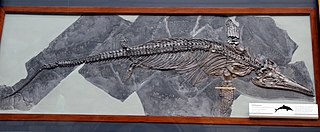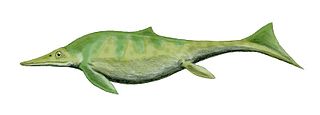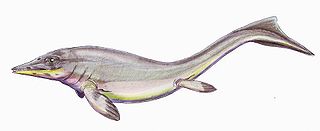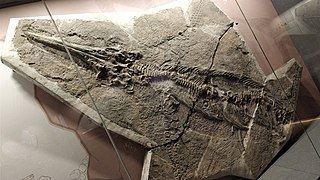
Ichthyosaurs are large extinct marine reptiles. Ichthyosaurs belong to the order known as Ichthyosauria or Ichthyopterygia.

In the geologic timescale, the Middle Triassic is the second of three epochs of the Triassic period or the middle of three series in which the Triassic system is divided in chronostratigraphy. The Middle Triassic spans the time between 247.2 Ma and 237 Ma. It is preceded by the Early Triassic Epoch and followed by the Late Triassic Epoch. The Middle Triassic is divided into the Anisian and Ladinian ages or stages.

Shonisaurus is a genus of ichthyosaur. At least 37 incomplete fossil specimens of the marine reptile have been found in the Luning Formation of Nevada, USA. This formation dates to the late Carnian age of the late Triassic period, about 237–227 million years ago.

Rachitrema is a poorly known genus of ichthyosaur from the Triassic of France. Its remains were found in France by two independent collectors, towards the end of the nineteenth century. They were only isolated bone fragments.

Shastasauridae is an extinct family of Triassic ichthyosaurs that includes the genera ShastasaurusShonisaurus and Himalayasaurus. Many other Triassic ichthyosaurs have been assigned to Shastasauridae in the past, but recent phylogenetic analyses suggest that these species form an evolutionary grade of early ichthyosaurs rather than a true clade or evolutionary grouping that can be called Shastasauridae. Shastasauridae was named by American paleontologist John Campbell Merriam in 1895 along with the newly described genus Shastasaurus. In 1999, Ryosuke Motani erected the clade Shastasauria to include Shastasaurus, Shonisaurus, and several other traditional shastasaurids, defining it as a stem-based taxon including "all merriamosaurians more closely related to Shastasaurus pacificus than to Ichthyosaurus communis." He also redefined Shastasauridae as a node-based taxon including "the last common ancestor of Shastasaurus pacificus and Besanosaurus leptorhynchus, and all its descendants" and Shastasaurinae, which Merriam named in 1908, as a stem taxon including "the last common ancestor of Shastasaurus and Shonisaurus, and all its descendants." In an alternative classification scheme, paleontologist Michael Maisch restricted Shastasauridae to the genus Shastasaurus and placed Shonisaurus and Besanosaurus in their own monotypic families, Shonisauridae and Besanosauridae.

Contectopalatus was a primitive ichthyosaur, an extinct fish-like marine reptile from the Middle Triassic of Germany. It was originally named Ichthyosaurus atavus, and later Mixosaurus atavus. It was recognised as a valid genus by Maisch and Matzke in 1998, though other authorities argue that it is synonymous with Mixosaurus. It was 5 metres long.

Californosaurus is an extinct genus of ichthyosaur, an extinct marine reptile, from the Lower Hosselkus Limestone of California.
Himalayasaurus is an extinct genus of ichthyosaur from the Late Triassic Qulonggongba Formation of Tibet. The type species Himalayasaurus tibetensis was described in 1972 on the basis of fragmentary remains, including teeth, limb bones, and vertebrae. The entire body length of Himalayasaurus is estimated to have been over 15 metres (49 ft) in length. Himalayasaurus has since been considered a nomen dubium or "dubious name" because of the lack of features that set it apart from other ichthyosaurs, although the presence of distinct cutting edges on its teeth have more recently been proposed as a unique feature of the genus. Himalayasaurus belongs to the family Shastasauridae, which includes other large-bodied Triassic ichthyosaurs like Shonisaurus.

Omphalosaurus is an extinct genus of marine reptile from the Early Triassic to Middle Triassic, thought to be in the order of Ichthyosauria. Most of what is known about Omphalosaurus is based on multiple jaw fragments, ribs, and vertebrae. Specimens of Omphalosaurus have been described from the western United States, Germany, Austria and the island of Spitsbergen off the northern coast of Norway.

Grippia is a genus of ichthyosaur, an extinct group of reptiles that resembled dolphins. These ichthyosaurs were small, at 1–1.5 m (3.3–4.9 ft) in length. Fossil remains from Svalbard from the specimen SVT 203 were originally assigned to Grippia longirostris but are now thought to have belonged to a non-ichthyopterygian diapsid related to Helveticosaurus.

Guizhouichthyosaurus is an extinct genus of Ichthyosaur which existed during the lower Carnian stage of the Late Triassic in southwest China. The genus contains the single species Guizhouichthyosaurus tangae. It had been referred to the genus Shastasaurus in the past, but later study showed that it is likely distinct, since it lacks the characteristically short snout of that genus. The ichthyosaurs Cymbospondylus asiaticus, named in 2002, and Panjiangsaurus epicharis, named in 2003, are junior synonyms of this genus.

Phalarodon is an extinct genus of ichthyosaur. Its remains have been found in China, North America, and Spitsbergen.

Qianichthyosaurus is an extinct genus of ichthyosaur from the Ladinian and Carnian stages of the Late Triassic epoch. Its fossils have been found in southeastern China, in Carnian rocks of the Falang Formation near Huangtutang, Guizhou. The type species is Qianichthyosaurus zhoui, named by Chun Li in 1999. A second species, Qianichthyosaurus xingyiensis, was named from older (Ladinian) deposits in the Falang Formation in 2013 by Pengfei Yang and colleagues. Complete Qianichthyosaurus fossils are common in the Falang Formation, with both juveniles and pregnant specimens being known; its larger contemporaries, Guizhouichthyosaurus and Guanlingsaurus, are rarer.

Thaisaurus is an extinct genus of ichthyopterygian marine reptile that lived during the Spathian. Fossils have been found in Thailand.
Toretocnemus is an extinct genus of ichthyosaur. Its remains have been found in California, United States, in Triassic layers of the Carnian Hosselkus Limestone.
Wimanius is a mixosaurid ichthyosaur, and the only genus in the family Wimaniidae. It existed during the Triassic Period in what is now Switzerland. It was described by Maisch and Matzke in 1998 based on fossils found in the Monte San Giorgio Formation, and the type species is Wimanius odontopalatus.
Pessopteryx is an extinct genus of ichthyosaur from the Early Triassic (Olenekian) of Svalbard, Norway. The genus and two species, P. nisseri and P. pinguis, were named in 1910 by Carl Wiman. Its synonyms are Omphalosaurus nisseri, Merriamosaurus and Rotundopteryx. The genus Pessopteryx was transferred to the genus Grippia in 1929 but Pessopteryx was later re-separated from Grippia.
Quasianosteosaurus is an extinct genus of basal ichthyosaur known from the late Early Triassic of Spitsbergen of the Svalbard archipelago, Norway. It was first named by Michael W. Maisch and Andreas T. Matzke in 2003 and the type species is Quasianosteosaurus vikinghoegdai. The generic name is derived from Latin quasi, "almost", and Greek anosteos, "boneless" and sauros, "lizard", in reference to the preservation of the holotype which is almost exclusively a natural cast of the skull with very little original bone. The specific name is derived from Vikinghøgda, "Mount Viking", where the holotype was found. Quasianosteosaurus is known only from the holotype MNHN Nr. SVT 331, a partial three-dimensionally preserved skull consisting of the snout and orbital and postorbital regions. The skull is by far the largest Early Triassic ichthyosaur skull known, with estimated cranial length at 50 cm (20 in). It was collected from the lowermost Grippia Niveau of the Sticky Keep Formation, Sassendalen Group at Mount Viking, Sassendalen. A phylogenetic analysis performed by Maisch & Matzke (2003) found it to be a basal ichthyosaur, sister taxon to Hueneosauria.

This timeline of ichthyosaur research is a chronological listing of events in the history of paleontology focused on the ichthyosauromorphs, a group of secondarily aquatic marine reptiles whose later members superficially resembled dolphins, sharks, or swordfish. Scientists have documented ichthyosaur fossils at least as far back as the late 17th century. At that time, a scholar named Edward Lhwyd published a book on British fossils that misattributed some ichthyosaur vertebrae to actual fishes; their true nature was not recognized until the 19th century. In 1811, a boy named Joseph Anning discovered the first ichthyosaur fossils that would come to be scientifically recognized as such. His sister Mary would later find the rest of its skeleton and would go on to become a respected fossil collector and paleontologist in her own right.





















